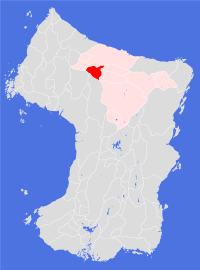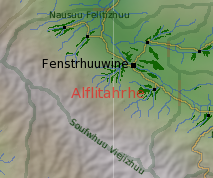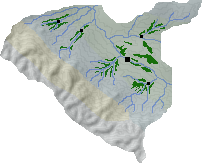Alflitahrhe

Societal ties: Ambostak
Current population: 1
Main language(s): Kumatti, Ramajal
Area: 97,000km²
Natural and political borders
The southern border of this Land is the Soufwhuu Viejizhuu, which includes the famed Long Mountain from which the range takes its name.
Alflitahrhe has control of the Ramuu river, and all its tributaries, south of latitude 38.9°N and west of longitude 171.5°E; and also the lower reaches of the Makinuu river west of longitude 171.2°E.
History
80,000 Kumatti people emigrated to Ewlah as part of the Hambosga relocation. But attempts to integrate the ethnic Kumatti minority population into wider Ambostak Society were mostly unsuccessful - by the gt630s the Kumatti were being routinely treated as second-class citizens in the Ramane State. Most Kumatti chose to live in more deprived areas of the three cities, their education standards were much lower and their health and well-being levels worse than the rest of the population.
In gt637, the Ambostak authorities suggested a radical solution to the problem - the establishment of a new Plantation specifically for the Kumatti people. The Plantation would be far inland, and would in effect be the first stage of a much larger expansion along the Ramuu river system. Many Kumatti welcomed this opportunity for a new start; the pioneer team that set out in gt638 included over 600 Kumatti labourers who were to be taught the science of soil brewing.
Fenstrhuuwine Plantation took root in the Nausuu Felitizhuu and proved to be very successful. From the start, the Kumatti were in a small majority and the Kumatti language underwent a revival. But it was never an ethnically pure settlement. From that time the people played little part in wider Ambostak politics, though most volunteered to serve some time in the Ambostak army and a few became significant players in Ambostak politics through that route.
The Land of Alflitahrhe was established in gt799 as part of the Treaty of Kestrhuuwe. The eighth century had been a time of growth for the people of the area, and by the time of the treaty four additional settlements had been established in the valley.

Politics and economy
To the Ambostak majority, the Kumatti people were exotic: their language was very different; their religion and customs were different; their approach to life was more laid back and, in a way, less earnest compared to Ambostak norms. For this reason, one of the first industries not connected to agriculture to take off in Fenstrhuuwine was tourism, with facilities first being built specifically for visitors to the city in the 720s. Today, the tourist sector is one of the main revenue generators for the Land.
Other key sectors include the mass production of pottery, linen, paper and glass, mainly for export. Agriculture revolves around the production of staple foodstuffs and traditional Kumatti herbs and spices. There is little heavy industry in the Land beyond local needs, and no mining beyond the production of clay, aggregates and cement.
Politically, Alflitahrhe is a representative democracy with political parties split across both ethnic and social lines. The current governing coalition has been in power for over 40 orbits. Most political activity takes place at the national rather than the local level, with local committees dealing mainly with parochial issues. Like all other Ambostak Lands, the currency remains the Ramane mark.
Culture and other issues of interest
It is doubtful if there are any ethnically pure Kumatti left in the Land: more than 500 orbits have passed since the decision was taken to establish a Kumatti settlement, and the Kumatti people have never felt the need to keep their stock pure. More useful are the figures of languages spoken in the home - around 35 per cent of people claim that both their parents spoke Kumatti in the home, with a further 20 per cent saying that one parent did so. The Kumatti language is very much the language of the street, the markets and the home, with Ramane being used in the workplace and in more formal situations.
Almost all people born in the Land, or moving to the Land, are happy to identify themselves as Kumatti; for instance Kumatti cuisine is far more popular than the Ambostak equivalent, and most people eat in the Kumatti style - communally, with many small dishes shared between friends. The Kumatti main meal is lunch, in contrast to the Ambostak preference for a large breakfast, and a good lunch will last from mid-day to mid-afternoon. To compensate, most people will work later into the night.
Whereas Ambostak religion is practical and interactive, the Kumatti tradition is to worship the God and Goddess in a more mystical manner, with much effort being put into the preparations for holy day feasts and parades. Kumatti art tends to revolve around the spiritual interpretation of the world, and Kumatti goods are routinely adorned with religious symbols. Ambostak and Kumatti temples coexist easily in the city and settlements, and many people are happy to attend both.
Key natural features
The Nausuu Felitizhuu is where the Ramuu river turns, flowing into the valley in a westerly direction and leaving it heading north east. To the south of the valley lies the Long Mountain, which forms a curtain of rock running some 140km between Mts. Alflituu (4,620m) and Viejuu (5,580m), never dropping below 3,400m in height.

Habitats
Four distinct habitats cut Alflitahrhe into strips running from the north west to the south east: The largest band, where most settlements are found, is the northern valleys habitat. South west of this band lies a northern scrublands habitat, beyond which lie the northern foothills and northern mountains habitats.
Plantations and settlements
Fenstrhuuwine Plantation, in the centre of the Land, is the only cultivation on the Ramuu river - all other settlements are built around tributaries. In addition to Fenstrhuuwine there are two settlements to the north west and one to the south east. A further settlement can be found along the lower reaches of the Makinuu river.
Key towns and cities
Rural population: 0 (0.0% of total)